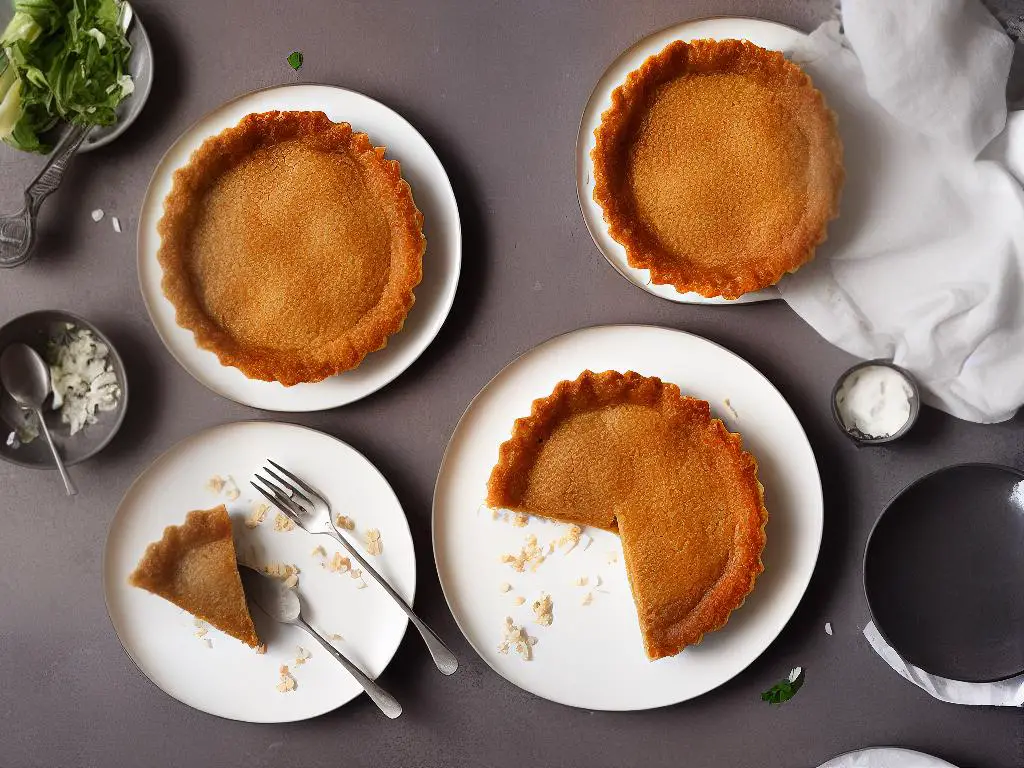Delving into the world of McDonald’s unique menu items, one may find themselves intrigued by the distinctive Taro Pie on the China menu. At its core, taro pie is a testament to the adaptability of fast food chains in catering to local tastes while preserving an international brand identity. This essay uncovers the origin of taro pie, explores its ingredients and cooking process, analyses its nutritional content, sheds light on its popularity and availability in different regions, and delves into the cultural significance of taro in China.
The Origin of Taro Pie
The Taro Pie from McDonald’s China: A Unique Dessert Offering with Historical Roots
The Taro Pie, a unique dessert offering from McDonald’s, is quite popular in China and has an interesting historical background. It is widely believed to have originated in the 1990s when McDonald’s was expanding its presence in Asia. In order to cater to local tastes and preferences, the fast-food giant decided to incorporate regional ingredients into its menu, and the idea of the Taro Pie was born. This innovation not only introduced a new flavour profile to McDonald’s dessert offerings but also demonstrated the company’s willingness to adapt and diversify its menu to accommodate varying food cultures.
The Key Ingredient: Taro
Taro, the key ingredient in the Taro Pie, is a starchy root vegetable commonly found in Asian cuisine. The plant, Colocasia esculenta, is native to Southeast Asia and Southern India. It has been cultivated for thousands of years for its edible corms, which are a rich source of nutrients, including dietary fibre, vitamins, and minerals. Taro is versatile and can be prepared in a variety of ways – it can be boiled, baked, or fried, and is used in both sweet and savoury dishes globally. In Chinese cuisine, taro is often used in desserts, such as pastries and sweet soups, which made it a fitting choice for a McDonald’s pie filling in the region.
The Practical and Strategic Choice
The introduction of Taro Pie in McDonald’s China was not only a strategic decision to appeal to local palates but also a practical one. Taro is a cost-effective ingredient, particularly in Asia, where it is widely grown and readily available. By using taro as a substitute for more expensive and imported fruits, McDonald’s could maintain its commitment to providing affordable and tasty food to its customers while also minimizing its environmental footprint by sourcing local ingredients.
A Beloved Item in McDonald’s Menu
Over the years, the Taro Pie has become a beloved item on the McDonald’s menu in China, garnering fans for its distinctive purple-coloured filling and sweet, earthy flavour. It has since been introduced in other countries across Asia, such as Hong Kong, Singapore, and the Philippines, as well as in some McDonald’s locations in the United States where there is a significant Asian population. The introduction of Taro Pie has allowed McDonald’s to reach a wider audience, who may not necessarily gravitate towards the chain’s more traditional Western dessert options, such as apple pie.
Listening to Local Tastes and Preferences
The success of the Taro Pie in McDonald’s China serves as a testament to the importance of catering to local tastes and preferences when developing menu offerings. By incorporating a regionally beloved ingredient in a familiar McDonald’s format, the Taro Pie was able to bridge the gap between Eastern and Western food cultures, ultimately resulting in a product that resonates with a wide range of customers. The Taro Pie exemplifies how McDonald’s continues to adjust its menu around the world, recognising the varying cultural backgrounds and tastes of its diverse clientele.

McDonald’s Taro Pie Ingredients & Cooking Process
McDonald’s Taro Pie
McDonald’s Taro Pie is a popular dessert item that has garnered an enthusiastic following in China. The pie prominently features taro as the main ingredient, which is a starchy, purple, and subtly sweet root vegetable native to Asia. The filling is made out of a blend of taro puree, sugar, and a binding agent such as cornstarch. This mixture creates a thick, creamy consistency that is sweet and reminiscent of ube or sweet potato, providing a unique taste experience while still maintaining a sense of familiarity within the McDonald’s menu.
Pastry Shell
To create the pastry shell, McDonald’s utilises a mix of all-purpose flour, water, salt, sugar, and a considerable amount of shortening or butter. The purpose of the shortening or butter is to generate flaky layers in the pastry as it bakes. This is achieved by incorporating the fat with the flour in a manner where it forms small pockets within the dough, which, when heated, creates steam and causes the layers to inflate and separate. The dough is typically thin and folded over to encase the taro filling before being crimped around the edges to prevent leaks.
Deep-frying Method
The taro pie’s irresistible texture is achieved through a cooking process involving deep-frying. This technique differs from the typical baking method used for other pie varieties. The filled pastry is submerged into hot oil, which instantly solidifies the outer layer and creates a golden, crispy exterior. This crispness juxtaposes the creamy sweetness of the taro filling, resulting in a delightful contrast that tantalises the taste buds.
Quality Control
In addition to the primary ingredients and deep-frying technique, it is crucial to underscore the importance of quality control during the cooking process. McDonald’s maintains a strict standard when it comes to their taro pies, ensuring that the oil is heated to the ideal temperature to avoid a soggy or overly greasy pastry and monitoring the time to prevent over or under-cooking. This is essential in achieving the perfect harmony between the pie’s exterior and the luscious filling within.
Variations in Quality
Lastly, whilst McDonald’s taro pies follow a validated recipe, variations in the quality of taro may slightly affect the overall taste and texture of the finished dessert. As with any fresh produce, the taro’s natural flavour profile and starch content can differ depending on numerous factors such as weather conditions during growth and time spent in storage after harvest. Nonetheless, McDonald’s China Taro Pie remains a consistent favourite among patrons, thanks to its divine combination of crunchy pastry and velvety filling.

Nutritional Information of Taro Pie
Taro Pie in McDonald’s China
Given its widespread popularity among patrons, it is worthwhile for the general public to become informed about McDonald’s China Taro Pie. Taro Pie is a delicious treat offered by McDonald’s in China, proving to be an interesting alternative to the familiar apple pie that is commonly available in other countries. Taro is a root vegetable originating from Southeast Asia, filled with flavour and vibrant purple colouring. As a dessert option, Taro Pie provides those seeking a sweet, indulgent snack with an exotic taste that is both unique and satisfying.
Nutritional Content
When it comes to the nutritional content of McDonald’s China Taro Pie, one pie contains approximately 270 calories. This figure should be considered when individuals are planning their daily caloric intake to maintain a balanced diet. As is typical with most dessert options, the Taro Pie’s calorie count mainly comprises carbohydrates and fats. The carbohydrates within the Taro Pie chiefly provide the body with energy; however, consuming excessive amounts could potentially lead to weight gain and other health issues.
On the other hand, the Taro Pie contains a few valuable nutrients that contribute positively to one’s diet. For example, taro itself is a good source of dietary fibre, which aids digestion and promotes healthy bowel movements. Additionally, taro is packed with vitamins and minerals, including Vitamin C, B6, and E, as well as potassium, manganese, and copper. These nutrients contribute to overall health by maintaining proper body function and strengthening the immune system.
Health Considerations
However, despite these benefits, it is crucial to recognise that McDonald’s Taro Pie is a deep-fried snack, generally high in fats, particularly saturated fats. Excessive consumption of saturated fats has been linked to increased cholesterol levels and heart disease risk. Consequently, enjoying Taro Pie should be done in moderation, ensuring that it is consumed as an occasional treat rather than a daily staple in one’s diet.
Conclusion
In conclusion, McDonald’s China Taro Pie provides an exciting twist on the classic apple pie, featuring the unique taste and vibrant colour of taro. Whilst it does offer certain health benefits due to the presence of vitamins, minerals, and dietary fibre, it should be consumed judiciously due to its high calorie, carbohydrate, and saturated fat content. As with many indulgent treats, moderation is key to maintaining a well-rounded and balanced diet whilst still savouring the delight of trying new and exotic flavours.

Popularity & Availability of Taro Pie
McDonald’s Taro Pie – A Chinese Favourite
One of the most popular desserts on McDonald’s menu in China is the tantalising Taro Pie. Taro, a starchy tuber, is a common ingredient in Chinese dishes and is loved by many for its hearty, sweet taste. By incorporating this familiar and well-loved ingredient into their menu, McDonald’s has successfully captured the attention and taste buds of local dessert lovers. The Taro Pie’s unique flavour is a staple on McDonald’s dessert menus across the nation, attracting a loyal following of fans in China.
A Fusion of Chinese Tradition and Fast Food
The key to Taro Pie’s immense popularity lies in McDonald’s ability to marry the traditional flavours of China with the convenience and modernity of fast food. The irresistible combination of crispy, golden pastry filled with a generous helping of comforting, creamy taro filling leaves Chinese customers yearning for more. Additionally, the irresistible aroma fills the air enticingly as customers dig in, making it difficult for even the most steadfast dieters to resist. For many Chinese people, the Taro Pie is an indulgence in nostalgia – a fusion of childhood memories and love for the sweet taste of taro.
A Unique Offering Tailored to Local Preferences
When compared to other McDonald’s dessert menu items such as apple pie or the strawberry sundae, the Taro Pie is particularly unique as it is tailored to cater to local preferences. By offering a dessert that is both familiar and exciting, McDonald’s has managed to set itself apart from other fast-food chains in China. As a result, the Taro Pie has become an integral part of the local McDonald’s experience, acting as a gastronomical bridge between Eastern and Western cultures.
Potential for Global Expansion in a Diverse Market
In countries outside China, the availability of the Taro Pie is limited. It can occasionally be found on the menu of McDonald’s locations in certain Asian countries like Singapore, Malaysia, and other nearby regions, though availability can be seasonal or limited-time only. Despite its undisputed popularity in China, the Taro Pie has yet to conquer the global McDonald’s dessert market.
That being said, there is potential for the Taro Pie to expand into other McDonald’s markets, particularly as a way to appeal to the increasing number of Asian consumers. As food culture evolves and an appetite for diverse flavours continues to grow worldwide, there is potential for menu items like the Taro Pie to gain popularity in regions seeking new flavours. By incorporating such culturally significant dessert items onto their menu, McDonald’s has the opportunity to create a culinary experience that bridges the gap between the traditions of different countries whilst satisfying the taste buds of a diverse global audience.

Cultural Significance of Taro in China
Taro in Chinese Cuisine and Culture
Taro, a versatile root vegetable, has held significant importance in Chinese culture for thousands of years. Its origins in China can be traced back to around 500-300 BCE, when it was predominantly grown in the southern regions. Often referred to as the ‘edible White Lotus,’ taro holds great cultural significance in Chinese society, as various dishes made from this root are consumed during important festivals, such as the Mid-Autumn Festival. Due to its rich and creamy texture, taro is featured in both sweet and savoury dishes in Chinese cuisine. In traditional Chinese medicine, taro is believed to offer health benefits and is thought to promote digestion and help build a strong immune system.
The Taro Pie at McDonald’s China
McDonald’s China introduced the Taro Pie in the early 1990s, acknowledging the cultural significance of taro in the country and aiming to cater to local tastes. Since then, the Taro Pie has become a popular dessert menu item in Chinese McDonald’s outlets. The sweet, purple, taro filling inside a crispy, golden crust has become a favourite among both locals and tourists. This product innovation by McDonald’s is an excellent example of how the fast-food giant has successfully adapted its menu to suit regional preferences and satisfy the palette of the Chinese audience.
Taro in Chinese Food Culture Today
The incorporation of taro into mainstream fast-food culture, as exemplified by McDonald’s Taro Pie, highlights China’s continued attachment to its culinary and cultural roots. In addition to symbolising prosperity and a connection to nature, the taro root is revered in Chinese history as a source of sustenance during times of scarcity. Its inclusion in a global food chain like McDonald’s is, therefore, a testament to the enduring importance of the many facets of Chinese cuisine and the cultural roots that underpin its culinary traditions.
Exclusivity and Authenticity
Moreover, the Taro Pie is seen as a unique offering exclusive to McDonald’s China, creating a sense of exclusivity and authenticity that resonates with consumers. The comfort of the familiar fast-food setting paired with the traditional taro flavour allows consumers to enjoy the best of both worlds. This meeting of cultures and culinary tastes helps to maintain interest and excitement in McDonald’s menus and offerings, resulting in increased loyalty and brand affinity.
Conclusion
In conclusion, the significance of the Taro Pie in McDonald’s China extends beyond its simple status as a dessert item. The choice to include this root vegetable in their menu highlights the company’s commitment to respecting and embracing cultural influences within their products. The Taro Pie serves as a great example of how global businesses can successfully adapt and incorporate regional preferences, creating a unique experience that acknowledges and enhances the cultural significance of each market they serve.

Throughout this engagement, it becomes apparent that McDonald’s Taro Pie in China is more than just a dessert item – it is a harmonious blend of ancient culinary traditions and modern food innovation. As the global fast-food landscape becomes increasingly dynamic, the taro pie exemplifies the importance of understanding local flavours and customs while delivering a product tailored to consumers’ preferences. The success of McDonald’s Taro Pie not only highlights the power of cultural adaptation in a market as vast and diverse as China but also serves as an inspiration for future culinary creations.
